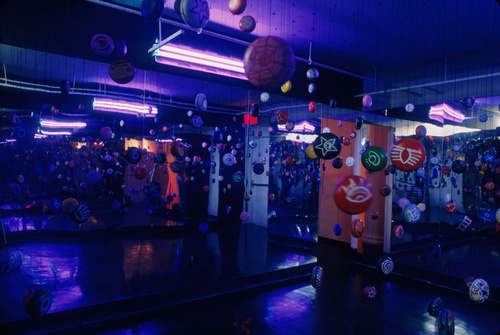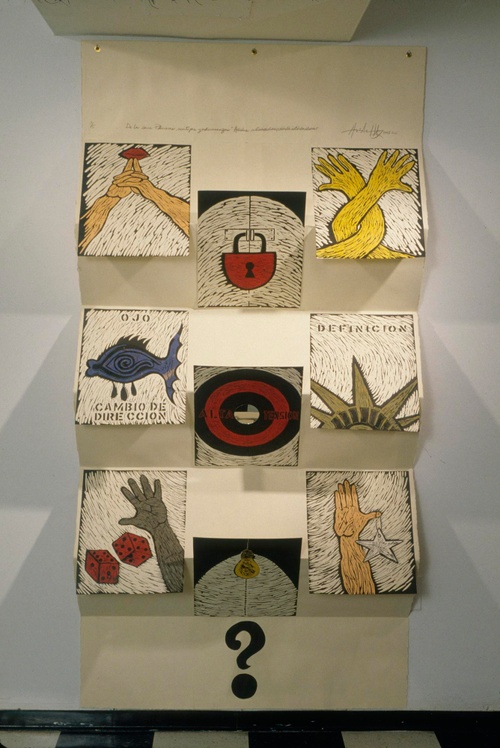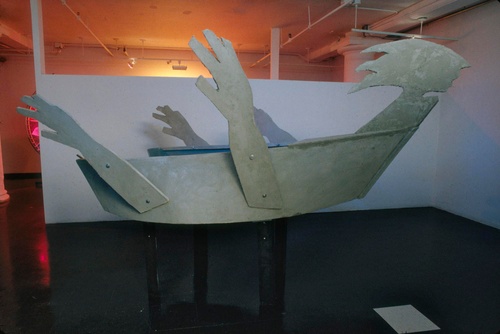Anaida Hernandez: Juegos Ilegales/Illegal games
Anaida Hernandez: Juegos Ilegales/Illegal games
“Anaida Hernandez: Juegos Ilegales/Illegal games” is emblematic of Anaida Hernandez’s commitment to the cause of human rights. Throughout her artistic career, Hernandez’s work has bridged boundaries of geography, class, ethnicity and gender by always inviting the public’s participation. In this interactive installation for the New Museum’s Public Access gallery, Hernandez invites visitors to enter a disorienting maze of corridors and rooms to try their luck at games of fortune and thereby experience life as it is lived by the undocumented immigrant. This metaphorical rite of passage mirrors the difficult conditions endured by immigrants seeking refuge in this country. Like the ebb and flow of migrations across national boundaries, Hernandez’s labyrinth is formless, dictated only by human passage and chance decisions. On entering Illegal Games the visitor/player negotiates a series of casino-like rooms by spinning a game wheel or by tossing dice encoded with colorfully painted symbols drawn from everyday life. Each symbol in Illegal Games represents an aspect of the American dream for the immigrant, and each move decides the consequent paths or pitfalls involved in attaining that dream. Purposely avoiding text, Hernandez relies exclusively on a lexicon of signs and symbols understood by people from all cultures and walks of life. In the first game room, Yo-Yo, I.D., the visitor/player enters a hall of mirrors filled with over one hundred and fifty yo-yos that hang from the ceiling. The yo-yos are painted with symbols that represent aspects of identity: nationality, ethnicity, sexuality, and the like. Reflected by the mirrored walls, the identity symbols are multiplied into a dense jungle of infinite possibilities. In Wheel of Fortune: The American Dream, the second game in the series, the visitor/player spins a roulette wheel at a gaming table, painted with corresponding symbols that determine the fate of the immigrant’s journey. A key represents opportunity. A star signals fame and fortune. The Statue of Liberty’s crown matches up with an image of barbed wire–a mixed message that points to freedom, but a freedom hard won. Illegal Games ends, appropriately enough, with a toss of the dice. In Loaded Dice, Hernandez has constructed a cement boat converting the hull into a playing board for a crap shoot. One die determines the player’s mode of transportation through a variety of symbols such as a plane, a boat, a bicycle, and a pair of feet. The other die determines the player’s fate with images such as a skull, a bridge, and a jail cell. The eagle is the ultimate prize, representing American citizenship. By responding to cues provided by these symbols, visitors/players confront their own desires, motivations, and aspirations while taking part in a bewildering new narrative. In the process, they are transformed from spectators to active participants, experiencing first-hand the choices and risks faced by immigrants in this country who must struggle every day to forge a sense of identity on a constantly shifting playing field. Currently based in Brooklyn, Anaida Hernandez was born in Mayaguez, Puerto Rico in 1954. She studied at the University of Puerto Rico in Mayaguez, then received her M.A. from the Escuela de San Carlos in Mexico City, where she studied painting and printmaking. Graphic arts have a long history in Puerto Rico, and Hernandez has been a major innovator in the field. She is widely known there for her politically conscious use of prints, paintings and site-specific installations to address domestic violence and other human rights issues. She frequently employs games, riddles or puzzles as a strategy for involving viewers in her work. As part of a series of game-related works, Hernandez constructed an immense crossword puzzle from hundreds of individual wood-cut prints which spelled out words pertaining to the tragedy of domestic violence. This monumental work on paper entitled Cruci-Grama (1995) extended the trajectory of traditional printmaking to a more interactive installation work which engaged viewers in the deciphering of its meaning. Here Hernandez reconfigured a fragmented jumble of letters and images on a grid to spell out a chilling text condemning violent acts against women. In a related installation, Till Death Do Us Part (1994), Hernandez placed one hundred small paintings in as many niche-like boxes, stacking these in rows to form a memorial wall dedicated to victims of domestic violence. Each of the one hundred nichos represented a tribute to one of the one hundred Puerto Rican women killed by their spouses between 1990 and 1993. Mementos were placed in each niche, adding personal content to an urgent social crisis. In this somber installation, the vastness of the trauma was poignantly underscored by the serial repetition of boxes, names, and dates. Like Hernandez’s previous work, Illegal Games draws our attention to a tragic social reality by equating its public implications with individual decisions we make everyday. As players in Hernandez’s game, we come to realize that the plight of undocumented immigrants–an underclass woven into the economic, social and cultural fabric of this country–is not merely an abstract political issue, but one with concrete personal consequences.





